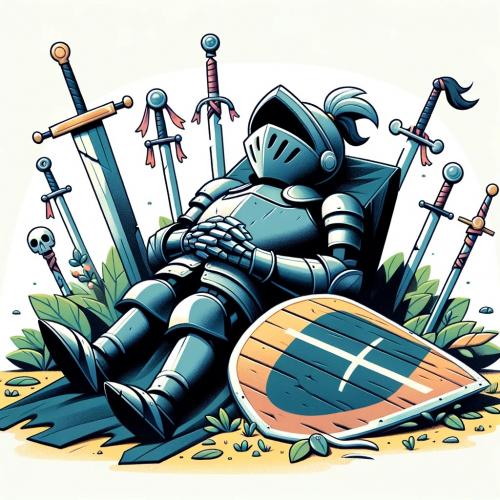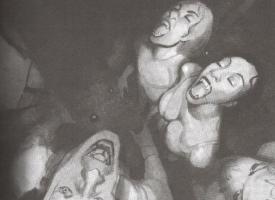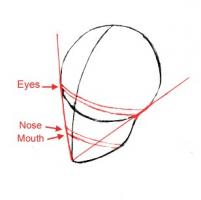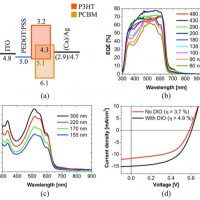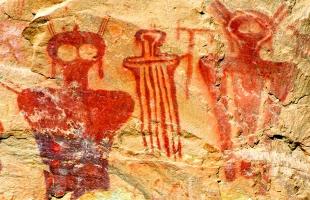Apocalypticism in Vampire: the Masquerade
Forgotten Lore - Issue 5

By Michael Andryuk
Introduction
Vampire: the Masquerade is an industry changing roleplaying game first released by White Wolf Publishing in 1991. Central to its impact on the roleplaying industry was a focus on story gaming, creating a complex setting for players and storytellers to explore. In particular, Vampire: the Masquerade and the spin off games that followed included the idea that the World of Darkness, the game’s dark reflection of our own world, was on the brink of apocalypse. In Vampire: the Masquerade this was represented by Gehenna, an apocalyptic end time when Caine, the brother of Abel and progenitor of Vampire, would return to judge his childer.
While it was at first a minor element in Vampire’s story, Gehenna set a new precedent in gaming. Previously, game settings were set in post- apocalyptic worlds and others had world shattering events. However, Vampire: the Masquerade was the first to have a looming end time that the game’s story slowly built up to. This finally culminated with the release of Gehenna in 2004, a book that provided four end times scenarios and ended the Vampire product line.
Gehenna is fictional event that is steeped in the Judeo Christian apocalyptic tradition. The writers and developers took pains to align fiction supplements such as The Book of Nod and Revelations of the Dark Mother with the pseudonymous works of Daniel, Ezekial, and the Revelation of Mark. The Book of Nod goes so far as to contain the Chronicle of Shadows, a segment prophesying events that would lead to Gehenna. Therefore, Gehenna can be analyzed both as a literary concept with the associated texts and as a game design mechanic. This paper focuses on the literary ideas of Gehenna, taking a look at the actual prose and the author’s intent behind them. In particular, the paper concludes what Gehenna represents in a literary context for Vampire, and how the author’s intent and subconscious views may have reflected the 1990’s and the coming millennium in particular.
This paper is organized into four sections preceding this introduction. First is an explanation of Vampire’s genesis mythology, which directly links to Gehenna. Following that is a look at the final nights themselves and the prophesized events of Gehenna. The next section looks at the author’s motivations, religious texts they looked at and any other relevant background. Finally, we conclude with answers of what Gehenna represents.
Genesis
All four scenarios presented in the Gehenna sourcebook relate directly to the genesis of vampires. The first deals with judgment by God, the second sees Lilith return, the third is Caine’s judgment on his progeny, while the fourth has the Antediluvian elders rise up and battle for the world. Each scenario uses the “sins of the father” theme, making it critical to understand at the origins of vampires before looking toward the end times.
Of Caine
Caine, brother of Abel, was spurned for sacrificing grain while his brother was rewarded for sacrificing flesh from a kill. Seeing that God craved blood sacrifice, Caine murdered his brother whom he loved most in offering to The One Above. Caine was banished by his father, Adam, to wander Nod alone.
In the dark wastes Lilith found Caine crying. The First Woman took the First Murderer into her home. Caine realized that Lilith had power beyond any mere mortal and wanted her to awaken him to true power. Lilith agreed and fed Caine her blood. The archangels descended on the scene and offered Caine mercy and forgiveness. Caine spurned each angel, determined that only he, not God, could truly judge and forgive himself for Abel's murder. In turn, each angel, Michael, Raphael, Uriel, and Gabriel, cursed Caine and made him the first Vampire. Uriel specifically curses Caine to “...walk forever in Darkness, all [he touches] will crumble to dust, until the last days,” which is the first apocalyptic statement found in Caine's mythology (The Book of Nod, 33). Under Lilith's protection, Caine learned supernatural powers, but he was dominated in her household. The seed of rebellion sewn, Caine ran from Lilith and left the land of Nod behind.
Then Caine found the First City, Enoch, and became its king. Caine sired three vampires – Irad, Zillah, and Enosch. These three in turn begat the 13 clan founders. The First City teemed with vampires who walked openly among mortals, enslaving them. Society collapsed when the 13 founders and their thin blooded progeny rebelled and slew their sires. Following this act, God, perhaps realizing his mistake, commanded a great flood of forty days and nights, which succeeded in destroying the weakest Cainites. After God's wrath, Caine withdrew from the world and watched his progeny war throughout the ages.
Three of Caine's grandchilder are particularly important to the prophesized Gehenna. The first is Malkav, a mad antediluvian who receives dreams and visions of the future. He is thought to have written the Chronicle of Secrets found in The Book of Nod. Second is [Tzimisce], an antediluvian master of crafting bone and flesh as if clay. Its childer all carry within them an infection stemming from the clan founder. Finally, there is Saulot, thought to be the gentlest of all Caine's progeny. Saulot traveled to the East and returned with knowledge of Golconda, a balanced state of being in which a Cainite no longer needs blood and returns to a human-like state. Saulot, however, was diablerized by Tremere, a mage who became a vampire.
Of Lilith
Lilith is the First Woman, created by YHVH from the same earth as Adam. A huntress, Lilith explored the Garden of Eden until she found the tree of knowledge and ate from it. Elevated to a higher state of being, Lilith refused to lay with Adam who complained to YHVH, who took Lilith as his own and created for Adam two other wives. When Lilith wanted to become YHVH's equal above all others, the god grew jealous and cast out the First Woman.
Lilith traveled the wastes and came upon the many gardens of the Elohim. At each she made love to the garden's keeper, partook of its fruit, and conceived monsters of land and sea. When she came upon Eden again she was stopped at the gate by Lucifer, the morning star. This angel was so enthralled by Lilith's beauty that he gave her the moon and a cloak of night, and let her enter Eden once again. There she tricked Eve into eating from the tree of knowledge and as a result YHVH destroyed Eden and cursed Adam, Eve, Lilith, and Lucifer.
Lilith and Lucifer left the ruins of Eden and set out into the desert to build their own Garden. While Lucifer was off shepherding the sun, Lilith came upon Caine alone and crying. Lilith took the weak, scared man to her garden and tortured him with fear and thorns to strengthen him. Then Lilith fed Caine her blood to strengthen him and left him to face the arch angels.
Years later, during the time of the First City, a spiteful Caine returned to Lilith's garden with his progeny. The war band murdered Lilith's children and burned the garden. Lilith, heartbroken, swore vengeance on Caine and all his children.
The Final Nights
Within The Book of Nod, the Chronicle of Secrets reveals signs which will portend Gehenna, when the secret world of vampires will come crashing down.
The exact nature of Gehenna is an enigma. Some passages say it is a place, such as the line “...the full sum of earth’s living will come and live in the Last City, called Gehenna” (The Book of Nod, 102). Other passages refer to it as an event, such as when a prophetic author warns that “...on these signs, you must know, that Gehenna waits, even at the door” (The Book of Nod, 112). Despite this inconsistency, Vampire’s fictional sources all agree that when Gehenna comes – literally or otherwise – it will bring about a new world order.
In the Gehenna sourcebook, as well as The Book of Nod there are a number of signs and portents that will herald Gehenna. As the Vampire product line continued, many of these signs appear and prophecies came true with surprising accuracy. Most of these elements are intrinsically linked to three underlying elements of Gehenna – weakening blood and power, rampant diablerie, and widespread mistrust.
The first sign is taken directly from Daniel and the Revelation of John – The moon will turn red and the sky will darken. However the actual sign is different. As of the sourcebook The Time of Thin Blood, the Red Star, called Antihelios, appears in the sky visible only to a select few vampires. This sign is visible to only a select few individuals with the power to read auras, of which red is the most hostile color. No one in kindred society can agree on what the star physically is and but all of them agree that it is the first overt sign of Gehenna.
A later sourcebook, The Red Sign, offers a use for Antihelios. In it, mages and vampires work together to harness the star’s power and ultimately return a vampire back to her mortal form. This individual, known as the Redeemed, is the first of many messiahs to appear as Gehenna approaches.
The next sign is a time of thin blood, when clanless will rule and vampires unable to sire will exist. In the background of Vampire the number of Caitiff, or clanless vampires, has increased dramatically following World War II. The Book of Nod offers particular warning that the clanless are “Lilith’s foul get” (107). However, The Book of Nod also cautions that the Caitiff can be quelled and accepted, stating “adopt the orphans where you can” (107). Intriguingly, in the Final Nights Cairo and Sydney are the domains of Caitiff Princes.
One perhaps false sign is that “Wild Ones will hunter vampires even in their strongest cities” (Gehenna, 21). In the setting of Vampire: the Masquerade, Cainites have been hunted for 800 years by a splinter group of the Catholic Inquisition known as the Society of Leopold. Additionally, the Federal Bureau of Investigation has been investigating the supernatural for nearly 80 years. However, corresponding to when Antihelios appeared, certainly divinely empowered mortals known as the Imbued began attacking vampires, lending some credence to this sign.
When Gehenna truly begins it is said that the eldest will awaken and consume all. It is commonly accepted that this will be the Antediluvians who awaken from their slumber and consume their progeny because the blood of mortals will no longer sate their thirst. Throughout the ages this was considered a myth, until the Ravnos antediluvian awoke in India in an event called the Week of Nightmares. While the antediluvian was destroyed, the Ravnos clan went into frenzy across the world, many of them burning in the sunlight.
The next event is that the Crone will awaken and consume all – which may have already happened when a wretched vampire called Baba Yaga awoke in Soviet Russia and began feasting on Cainites throughout Eastern Europe. However, the Crone may also be Lilith in Noddist lore – the mother of monsters who swore to return and destroy Caine’s bloodline.
The final event at first seems like hope. According to The Book of Nod, “When the snows consume the earth and the sun gutters like a candle in the wind then, and only then will there be born a woman, the last Daughter of Eve, and in her will be decided the fate of all” (103). However, the last Daughter of Eve is known by a crescent moon birthmark, the symbol of Lilith.
Author’s Intent
When Mark Rein·Hagen first sat down to write Vampire: the Masquerade he knew he wanted it to include biblical undertones. Having grown up in a religious household – his father was a Lutheran minister – biblical underpinnings fit with the theme and mood he wanted in the game. Gehenna and the approaching end times were a footnote in Vampire: the Masquerade 1st Edition, a prophecy that the Antediluvians would someday consume their childer. As the Vampire game continued to expand, Gehenna became a strong theme – an event to fight against that gave the World of Darkness a foreboding atmosphere.
The idea of Gehenna was taken to the next level in the Players Guide to the Sabbat, which introduced a diabolic vampire faction. To make them more empathetic and playable, developer Andrew Greenberg made their ultimate goal the defeat of Antediluvians and stopping Gehenna.
The Book of Nod, written by Sam Chupp and Andrew Greenberg, was the first supplement to truly expand Gehenna from a one sentence idea to a titanic event. Sam Chupp wanted the book to have mythic resonance – an idea coined by Joseph Campbell – meaning that the story would borrow from the folklore and religious texts to give it more credence.
Sam Chupp, who wrote The Book of Nod’s biblical style passages, attended a southern fundamentalist private school when he was younger and feels the “bible thumping, fire, and brimstone education” really affected the writing of the book. Sam was especially inspired that the Revelation of John was originally a political tract, pseudonymously written to spur early Christians into action. Sam wanted to take that same approach – of “using one thing and using it to say another” – when writing The Book of Nod. Sam especially wanted to borrow aspects from the Book of Revelation, since he felt contemporary apocalyptic fiction, such as The Rapture series, did not do the source material justice and was largely made up. Sam especially enjoys that Revelation has been massaged over the years to send chills up your spine. This aspect is especially obvious when Sam was asked about particular aspects of the writing. For example, the Last Daughter of Eve was simply put in to highlight a female character that would be important to the end times. This character, as well as others like Saulot and the Redeemed, wound up having mythic resonance of messiah figures.
In some background of Vampire: the Masquerade Saulot can be seen as a Vampire messiah, but in others he has more devilish aspects. Sam Chupp revealed that Andrew Greenberg and the original author of the Salubri clan had an argument about whether or not good and caring vampires could even exist since vampires are “the most selfish of creatures.” Indeed, while Saulot may be viewed as the only Antediluvian that may protect kindred, it is commonly theorized that he may have sired the Baali - a bloodline of demon worshiping vampires.
Ultimately, the authors’ goal for Gehenna was to figure out what would scare vampires and they decided to use elements of apocalyptic literature to enhance their story.
Analysis and Conclusion
Gehenna, as presented in Vampire: the Masquerade, uses many themes of apocalyptic literature. In addition, several elements and ideas are taken from literature like the Revelation of John and Madras of Lilith to enhance the story and lend it more credibility.
Gehenna has many aspects of traditional apocalyptic works, some of which are turned on their head. Christian apocalyptic text was written for an oppressed people, showing them a reward that would come – a brighter future. The apocalypse that Gehenna represents is the opposite – vampires are predators on the top of the food chain and they fear losing their position. First, the vampire's blood is what gives them their physical strength and magic powers, so a plague like the Time of Thin Blood scares them. Additionally, vampires can only survive in the modern day of cell phone cameras and closed circuit television because of their society and ability to masquerade as humans. If their thousand year old society, crumbles, then they lose much of their power and security.
Despite this, the Gehenna source material does provide some sliver of hope for vampires. First, The Book of Nod provides us with one overt messiah – the Last Daughter of Eve. This woman, within whom the fate of all will be decided, is a clear allusion to the second coming of Christ purported in the Revelation of John. However, she has a dark side – the moon birthmark by which she is known is the symbol of Lilith. While the symbol is open to the readers’ interpretation, it's quite possible that the Last Daughter of Eve may in fact be evil. In a literary context, this symbol represents, if nothing else, the will for humanity to survive despite the most desperate odds. What it means for vampires is unknown.
The next messiah is the Redeemed, an optional character from The Red Sign. This character works with hermetic mages to harness the power of Antihelios in a ritual to return her to mortal form. The Redeemed represents a small scale messiah who could only save a select few. However, simply the knowledge that one could return to mortal life is very powerful for vampires that cling to their humanity.
Finally, there is Saulot, the most enigmatic of all messiahs. Some material portrays him as selfless. Others as a devilish master of manipulation. Yet despite his questionable motivation, nearly everything hints that he wants to avert Gehenna. Saulot's presentation of Golconda, a nigh unachievable state of grace, gives many humanity driven vampires a goal to strive towards. Saulot even mirrors the second coming of Jesus since he effectively returns to life. When Tremere diablerized Saulot he was unable to fully absorb Saulot's soul and the antediluvian was eventually able to take over Tremere's body and oust the mage's soul. Now inhabiting another body with no need of vampire blood to survive, Saulot is one of the few antediluvians active in the final nights prior to Gehenna.
In addition to Saulot, two other antediluvians appear actively in the Final Nights. The first is Ravnos, who awakened beneath the earth in India and was only defeated by a coalition of supernatural forces. Ravnos represents something commonly found in apocalyptic literature – the monster from the depths, such as the four monsters found in Daniel. Ravnos also represents something else not found in apocalyptic literature – when the Ravnos antediluvian is killed his clan is driven mad and most perish. Nothing in preceding Vampire lore hinted at this event and it is unclear if it would happen again. However, since there are thirteen vampire clans and the Ravnos are the first to be lost, it forms a parallel to the thirteen tribes of Israel.
The final being is the Tzimisce antediluvian – which seems to have abandoned its humanity and become a disease infecting its progeny. [Tzimisce] represents a non-traditional apocalypse inspired by body horror, where the antediluvian may consume all life on earth and turn the planet into a mass of flesh. This end is clearly unsupported by traditional apocalyptic literature and seems to have more in common with the modern zombie apocalypse. This end, brought about by inescapable conformity, is especially terrifying for those in the relatively free western world.
The signs of Gehenna are not clear to anyone. Only the most learned and erudite are able to decipher the texts of The Book of Nod. Many Gehenna prophecies over the years have been created by the mad progeny of Malkav, who speak riddles of visions they receive. One aspect of The Book of Nod that Sam Chupp revealed in an interview is the Mnemosyne, or memory-seekers, who compiled the book are actually a rare bloodline of vampires able to derive stories and information from symbols and secrets left at physical locations. While none of these groups have a true link to heaven, it is interesting that they have supernatural means of learning about the end times.
Finally, Gehenna truly represents a judgment of the wicked – vampires are selfish creatures that live among humans like parasites. This is why Gehenna is such a powerful element in Vampire – the Cainites are clearly evil and will one day be punished. The Book of Nod states that “none will say when Caine will arise... and call for the city Gehenna, the Last City, the City of Judgment” (55). Caine set forth his own traditions, like the commandments, for his progeny to follow and it is by these rules that he would judge his childer. This significantly differs from traditional Judaism, where the covenant theodicy exists. It is also poignant that God is completely missing from this judgment – in Vampire, the being seems to have become laissez- faire following the Great Flood.
Many of the signs and themes found in Gehenna also have particular relevance to the 1990's and modern society. Author Sam Chupp stated that he set out to write an accurate portrayal of a vampire holy text and he truly succeeded with The Book of Nod. So much so that misguided individuals have contacted him, claiming to be from the Church of Nod, and asking who revealed these vampiric truths to him. The book's prose speaks to many people and definitely contains some subconscious warnings about the future.
[Tzimisce's] infection is spread through the blood, much like HIV. Vampires are inherently sexual predators and it is easy to draw parallels about unwarranted and promiscuous relations.
Likewise the Time of Thin Blood shows a loss of power for the eldest vampires, which they blame on the young and weak rabble around them. The allusions of this are fairly clear – people in power never want to lose power and this is a linchpin of the equality debates raging throughout U.S. History.
Intriguingly, the fear of clanless can have much different connotations. Rather than racial tension, the Caitiff are societal outcasts and deviants. White Wolf championed homosexuality in gaming during the early 90's and The Book of Nod's passage regarding the clanless is a strong allusion to their struggle, calling them dark seeds who “will cry aloud for justice,” and pointing out how they are a subculture with “no family... no generation... no tradition... no hospitality [given]” (107). The passage however recommends that society work out its differences with homosexuals, stating “Pity them! Adopt the orphans where you can” (The Book of Nod, 107). While not the most powerful call to arms it is an interesting look back only fifteen years ago.
Gehenna has many more facets to explore – this treatment only covers a few of the more prominent ideas. Over 100 Vampire: the Masquerade books were published, many of which deal with the end times in some way. Just like scholars looking back at apocalyptic literature, these books provide a glance at the values and conflicts of people living in the 1990's.
Lexicon
- Kindred – A vampire (contemporary term)
- Cainite – A vampire (classic term)
- Sire – A vampire who creates another vampire through the act of the Embrace.
- The Embrace – Creating a vampire by draining a mortal of their blood and replacing it with a small amount of vampire blood.
- Childe – A sire’s vampire progeny.
- Antediluvian – An ancient vampire that created one of the 13 modern clans. Survived the biblical flood.
- Clan – A bloodline of vampires sharing similar powers and weaknesses.
- Caine – The biblical Cain with an extra ‘e’ just to be edgy.
- Thin Bloods – Vampires so far removed from Caine that they can no longer embrace mortals.
- Jihad – The war of ages waged between ancient vampires.
- Diablerie – The act of one vampire draining another vampire’s blood and by doing so absorbing their soul and power.
- Caitiff – A clanless vampire, the lowest rung of society.
References
- Rein·Hagen, Mark, et al., Vampire: the Masquerade, 1st ed., 1991, White Wolf Publishing, Stone Mountain, Georgia.
- Achilli, Justin, et al., Vampire: the Masquerade, Revised ed., 1998, White Wolf Publishing, Stone Mountain, Georgia.
- Chupp, Sam, and Greenburg, Andrew, The Book of Nod, 1994, White Wolf Publishing, Stone Mountain, Georgia.
- Brucato, Phil, with Udell, Rachelle, Revelations of the Dark Mother, 1998, White Wolf Publishing, Stone Mountain, Georgia.
- Friedmen, C.S., The Erciyes Fragments, 1998, White Wolf Publishing, Stone Mountain, Georgia.
- Achilli, Justin, et al., Gehenna, 2003, White Wolf Publishing, Stone Mountain, Georgia.








